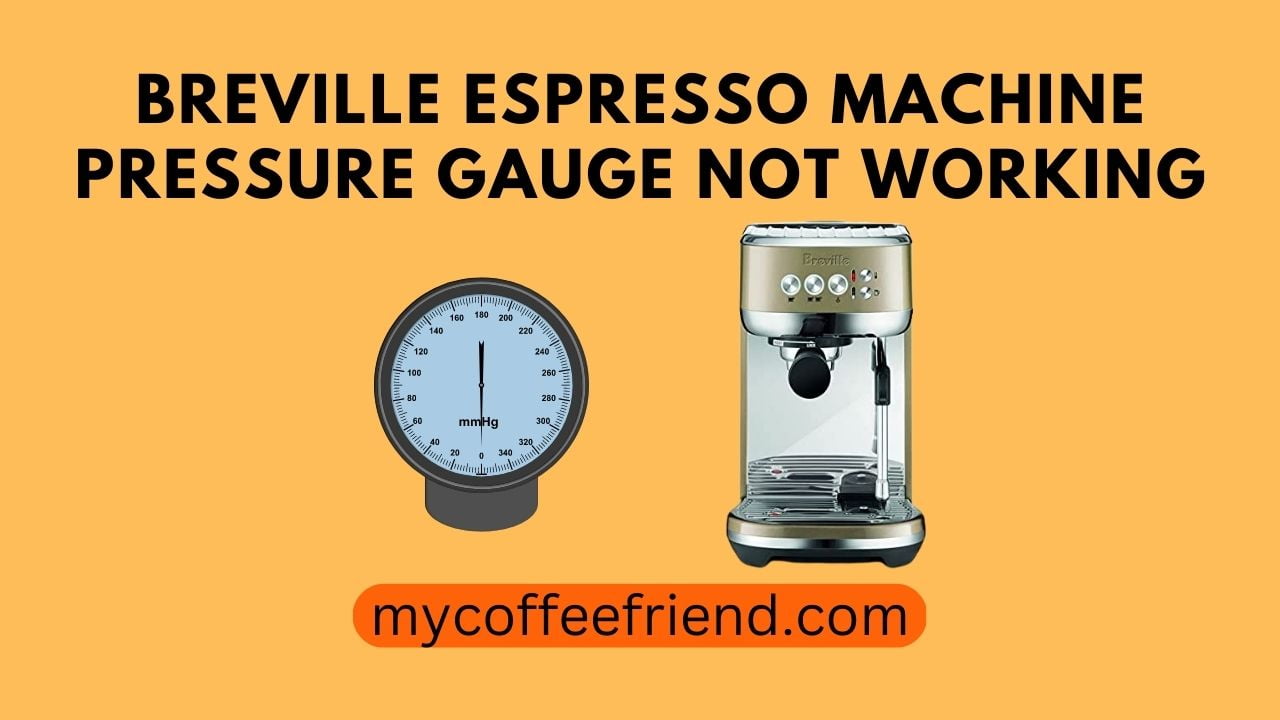Is your Breville espresso machine pressure gauge not working?
Being a coffee lover and an espresso machine user, you might face a barista espresso machine pressure gauge problem.
You might not be able to enjoy the hot sip of your favorite espresso after a tiring schedule. Now you are here you find the reason behind the malfunctioning of your espresso pressure gauges.
Don’t worry we are here to help you to find the answer to your question:
Why is the pressure gauge of my Breville espresso machine not working? The main reason can be the use of less grounded coffee ( you added to make espresso) or broken pressure gauges.
Some other reasons can cause the malfunction of the espresso machine pressure gauge. In this article, we are going to discuss the most common reasons one by one. Not only the reasons we will also discuss the solutions to fix the problem. So, without any further ado let’s just dig into the article.
Table of Contents
Toggle6 Reasons: Why Pressure Gauges Are Not Working?

The following are the reasons for the malfunctioning of pressure gauges;
- Pressure Gauge Malfunctioning
- Using Tap Water To Make The Coffee
- Use of too much coffee
- Pressure regulators
- Seal and Gaskets
- Less ground coffee
Pressure Gauge Malfunctioning
If your Barista Espresso Machine is many years old. Most probably the pressure gauges of your machine are broken. If that’s the case you have to replace the pressure gauges.
Take the machine to a technician. But it does not happen all the time, especially when you are using your new espresso machine. So, check out for the other reasons as well.
Using Tap Water To Make The Coffee
We all know that tap water contains calcium, and magnesium which makes it hard water. The minerals present in hard water can easily cause a blockage.
These minerals clump inside the water line of your espresso machine and block the way of dropping coffee.
This is because a blocked water line builds up low pressure and low coffee pours out of the machine. That’s why when you take your espresso machine to a technician you are recommended to use filtered water.
Instead of using tap water filtered water is recommended so that you can prevent your Barista espresso machine from future damage.
Use Of Too Much Coffee
Sometimes, we add an excessive amount of ground coffee to prepare the espresso. Mostly we do this when we are in a big hurry to get a good amount of espresso in less time.
But then, Instead of getting a large amount of espresso, we lost the function of our machine. Therefore, always try to add a limited amount of ground coffee to save your machine. The high amount of ground coffee also causes to put less pressure and makes less coffee.
Pressure Regulators
In many cases, the pressure regulators of the Barista espresso machine stop working. The malfunctioning of the pressure regulator leads to less pressure. When the pressure regulators do not work properly and put less pressure the espresso machine stops preparing coffee.
Seal And Gasket
Espresso machines are designed with rubber gaskets just like rubber inside a pressure cooker. This helps to maintain the high pressure and to provide a sealed and airtight environment. Sometimes the gaskets break and get damaged due to excessive use.
Gaskets can also be damaged due to fats, oils, and water minerals like calcium. Then the barista espresso machine starts generating less pressure and a low amount of coffee. Damage or broken gaskets also cause the bottom leakage.
Less Grounded Coffee
When we add less ground coffee into the Barista espresso machine it doesn’t only ruin the taste of your coffee. Whereas, it can also be a cause of less pressure and less brewing coffee in the Espresso machine.
Test The Pressure On The Breville Barista: 6 Easy Steps To Follow
- Create an airtight environment by placing a clean rubber cleaning disk into the portafilters
- Fill the water into the tank. Remember do not add any coffee beans while the whole checking process
- Now it’s time to select the number of cups. Then press the 1-cup button
- Look carefully at the pressure gauge and note the reading while coffee is brewing from the machine.
- If you see the reading of 8,9 and 10 pressure gauges are working well
- It takes 30 seconds to prepare a perfect shot of coffee
Watch the Video For the Test
How To Maintain A Balanced Pressure And Fix The Low-Pressure Problem
If the pressure of your Barista Espresso machine is low. Following are some helpful solutions you can follow:
- If the pressure gauge of your machine is broken you should take the machine to a technician. The best option is to ask the technician to replace the gauges instead of repairing them if the gauges are a little old.
- If the gasket of your Espresso machine is damaged or broken you can replace it on your own. But, most preferably you should take the machine to a technician and replace the gasket.
- One of the easiest and less time-consuming methods is cleaning. It can solve almost all your issues in a short time. While cleaning properly remove the oils, fats, minerals, and limescale.
- Use a limited and measured amount of ground coffee beans. A high or low amount can also cause problems
- Tamp the ground coffee properly. It can help the coffee particles get close and airtight. In this way, the machine can be saved from pressure changes.
5 Solutions To Fix: Breville Espresso Machine Pressure Gauge Not Working

Solutions that can fix the pressure problem are given below:
- Repair or replace the pressure gauges
- Repair or replace rubber gaskets
- Clean the machine regularly
- Use the required amount of coffee
- Tamp the coffee properly
Repair or replace the pressure gauges
Many times the pressure gauges stop working due to the reasons we already discussed above. Therefore, we need to repair or replace the pressure gauges.
You can just repair the gauge but the machine can stop working again. That is why the best option is to replace the pressure gauge.
Repair And Replace The Rubber Gasket
This problem can also be fixed just like the pressure gauge issue. You should take the machine to a technician to repair the rubber gasket. Replacing is more recommended instead of repair.
Clean The Machine Regularly
Cleaning the machine properly regularly can save your machine to stop working or working slowly. Especially the water line where the water minerals block the line.
Other debris like fats, oils, and limescale also cause fluctuation in pressure. Many of the problems can be solved by just proper cleaning of the machine.
Use Limited Coffee Grounds
If you use a high amount of coffee ground it will affect the pressure. Similarly, if you can use a low amount of coffee it will also affect the pressure. Therefore using a limited amount of coffee can solve the pressure problem
Tamp The Coffee Well
Tamping of the coffee cause the air between the particles of the coffee which leads the pressure problems. Once you tamp the coffee well you can be saved from pressure problems.
Conclusion
Sometimes the pressure gauge of the Barista Espresso machine gets damaged or stops working. There might be many reasons behind it. But, the main reasons are broken pressure gauges, less ground coffee, and damaged pressure regulators.
We have already discussed all the problems, reasons, and solutions one by one. Hope you enjoyed reading the article and that it helps you to find out the reason for the malfunctioning of your Barista Espresso machine and the solution.






